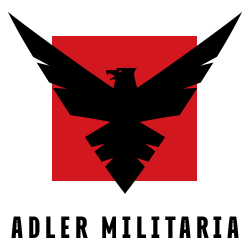Showing 136–144 of 1093 resultsSorted by latest
-
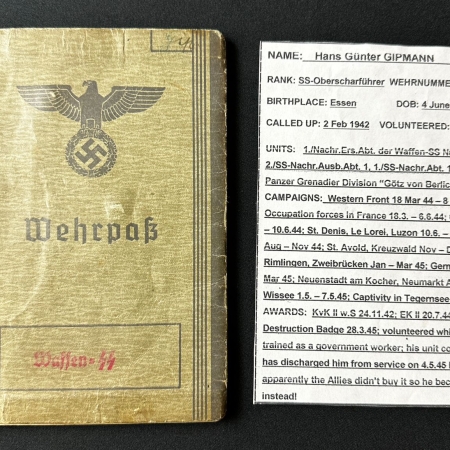
WWII Original German Waffen SS Wehrpass – SS Oberscharführer Hans Gipmann – “Tank Destruction Badge” – SS Nachrichten Abteilung 17 “Götz vn Berlichingen” – West Front – Carentan Normandy 1944 – Surrendered to the US 101st Airborne – Rare
Hans Günter Gipmann from Essen/Düsseldorf Germany (born in 1924). Reached the Rank of SS Oberschärführer He was a member of the Hitler Youth, awarded the HJ Leistungs Badge in Silver. As well as DLRG Life saving permit, as well as a Land War Training HJ Certificate. He was assigned in 1942 to the Waffen SS after volunteering to the SS Signals School in Nürnberg, Germany. Taking his SS Oath on the 12th of May 1942. He was deployed with the first company of the SS Signals Detachment 17 – SS Nachrichten Abteilung 17 “Götz vn Berlichingen” He was trained on the K98 Rifle, Handgrenade Model 24, MG 34, Luger P08. He was to be used on the frontline in the best case as a, Radio Man and Troop Leader. In the Second case as a MG42 Gunner or Panzerfaust Gunner. Awarded the War Merit Cross Second Class with Swords in 1942, in combat awarded the Iron Cross Second Class on the 20th of July 1944 and the Tank Destruction Badge on the 28th of March 1945. Unit History: The division was raised near Poitiers, France, as the Panzer-Grenadier-Division “Götz von Berlichingen” in October 1943. It was formed from scratch, with the majority of its original cadre coming from replacement units and conscripts, many of whom were Romanian Germans and French volunteers. After September 8, 1943, around five hundred Italian volunteers, coming from units deployed in France were enlisted in “Götz von Berlichingen”. The division was granted the honour-title Götz von Berlichingen.[nb 2] Obersturmbannführer Otto Binge oversaw the formation of the division, with the newly promoted Brigadeführer Werner Ostendorff taking command in January 1944. The Götz von Berlichingen was placed under the LXXX Army Corps, a part of Generalfeldmarschall Gerd von Rundstedt’s Heeresgruppe D. As part of a plan to number all named SS divisions in early 1944, the division was re-titled the 17th SS-Panzer-Grenadier-Division “Götz von Berlichingen”. In February 1944, the division still lacked vehicles. During the same year, on the orders of LXXX Army Corps, the division began to round up French vehicles in an attempt to complete its mobilization. By March, most of the major combat formations were fully motorised, although two of the six infantry battalions were still on bicycles. On 1 June, the Götz von Berlichingen found itself at Thouars in France, with no tanks (although the crews were fully equipped with 42 Sturmgeschütz IV assault guns), only a few months’ training, and below strength in officers and Non-commissioned officers. After the Allied invasion of June 6, 1944, the Götz von Berlichingen was ordered to Normandy to take part in the efforts to reduce the Allied beachhead. On June 10 the division made contact with 182 paratroopers of the 3rd Battalion, 507th Parachute Infantry Regiment, part of the U.S. 82nd Airborne Division, and B Company, 501st Parachute Infantry Regiment, of the U.S. 101st Airborne Division, at the village of Graignes. This small group of paratroopers had been dropped mistakenly by the U.S. 9th Army Air Force Troop Carrier Command and had decided to try to hold their positions. The ensuing battle, and the criminal execution of wounded paratroopers and French civilians by the “Götz von Berlichingen”, has since been known as the Battle of Graignes. On June 11 the reconnaissance battalion engaged in combat near the town of Carentan with the paratroopers of the 101st Airborne Division. The Americans secured the town and were advancing south by the morning of June 13. SS-Panzergrenadier Regiment 37, supported by the assault guns of the division’s Panzer battalion and Oberst (colonel) Friedrich August Freiherr von der Heydte’s 6th Fallschirmjäger Regiment, attacked the advancing American paratroopers. In what the Americans dubbed the Battle of Bloody Gulch, the Germans routed two paratroop companies before their attack was stopped by the arrival of Combat Command A of the U.S. 2nd Armored Division. For the rest of the month, the division was engaged in heavy fighting for the bocage country near Saint Lô and Coutances. During this period, the Götz von Berlichingen suffered heavy losses and by the beginning of July, its strength was reduced to 8,500 men. The division was in the line of advance for Operation Cobra, and suffered heavy losses attempting to halt the Allied offensive. It was encircled by the U.S. 2nd Armored Division around Roncey where it lost most of its armored equipment.[3] It was then ordered to take part in the Mortain Offensive, codenamed Operation Lüttich. After the failure of this offensive, the division was split into four Kampfgruppen, ‘Braune’, ‘Gunter’, ‘Fick’ and ‘Wahl’. These small units managed to escape encirclement in the Falaise Pocket, but suffered heavy losses and remained in almost constant combat against the advancing Americans until the end of the month, when the division was transferred to Metz for a much-needed rest and refit. In July the reserve battalion of the division was involved in counterinsurgency action against Operation Bulbasket in the Vienne Department. In early September, the division absorbed what was left of the SS Panzergrenadier Brigade 49 and SS Panzergrenadier Brigade 51, raising its infantry strength. However, replacements for missing panzerjaeger and assault guns arrived slowly. On September 8, the division was put back into the line and was tasked with destroying the newly formed bridgehead over the Moselle River held by the US 5th and 80th Infantry Divisions. After heavy fighting for the American bridgeheads at Dornot and Arnaville, the division fell back and began to prepare to defend Metz itself. Over the next two months, the division saw heavy fighting to the south and east of Metz, suffering very heavy casualties. On November 8, a USAAF air raid hit the divisional command post. With the Götz von Berlichingen’s combat units in tatters (the 38th SS Regiment had been reduced to a strength of about 800 men by November 15, 1944[4]) and with no command structure, Hitler authorized the division to withdraw from Metz. The 38th SS Regiment was largely destroyed at Metz and reformed in November with troops…
-
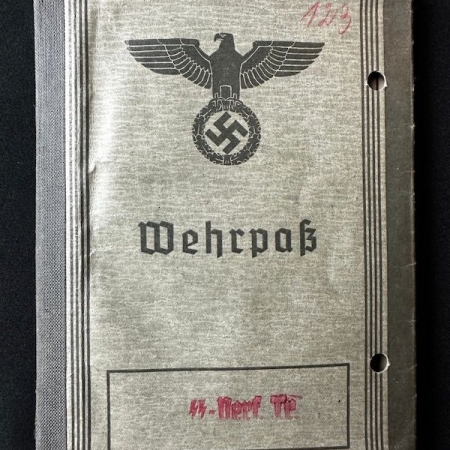
WWII German Waffen SS Wehrpass – SS Oberscharführer Karl Hilgarth – SS Verfügungstruppe – “Deutschland” – Holland Schelde 1939 – Stabskompanie Hauptamt RFSS Kommandostelle Hegewald – Rare
Very interesting Wehrpass Issued to Karl Hilgarth , born 27,2,1919 in Germany. He was unmarried when he enlisted as a student directly into the Waffen SS in Munich. His Wehrpass is issued by SS Regiment Deutschland in October of 1939. According to page 11, he joined 8th Kompanie, SS Deutschland in Munich. Interestingly, he did not swear an oath until 23.8.1944. He was trained on the K98 Rifle, Luger P08, Handgrenade model 24, MG 34. Promotions: 1.11.1940 – SS – Sturmmann 20.4.1941 – SS – Rottenführer 1.8.1941 – SS Unterscharführer 1.6.1943 – SS Oberscharführer Awards: Wounds Badge in Silver Iron Cross Second Class – Feld Kommandostelle RF SS – Himmler’s “Feld Kommandostelle” (“Field Command Unit”) which, at that time, was the SS Field Headquarters at the Hegewald bei Zhitomir Ukraine. Interestingly, the Wehrpass has a large battle calendar, starting in 1939 – Poland (Modlin), Western Front (Holland Schelde, Island Boveland und Walscheren, Hasebrouck), France (Avre, Siene, Dijon, Langres), Southwest France – Spanish Border, Security in Holland December 1940 – 1941 – Russia (Dnjeprstellung, Jelnja) On the 4.8.1941 – he was wounded with a grenade splinter – Grenade Splinter left arm amputated at Jelnja. After a short stint in a replacement company, (Genesungskompanie SS “D”), he was assigned to the Stabskompanie der Waffen SS bei der Rasse und Siedlungs Hauptamt SS. Unit Background: Elements of the SS-VT served with the Wehrmacht during the occupation of the Sudetenland, Austria, and Czechoslovakia. For those operations, the SS-VT was under the command of the army. The SS-VT also formed an Artillery Regiment during this time-frame which was used to fill the gaps in a number of army units for those events. The SS-VT regiments Deutschland and Germania along with the Leibstandarte participated in the invasion of Poland, with Der Führer (recruited in Austria after the Anschluss) in reserve at Prague. In September 1939, a combined unit of SS-VT and Heer (army) troops conducted operations jointly as Panzer Division Kempf during the invasion of Poland.[18] It fought alongside army units at Rozan, Modlin, Łomża and Kmiczyn. The division was disbanded near the Polish city of Nidzica on 7 October 1939. In spite of the swift military victory over Poland in September 1939, events during the invasion of Poland raised doubts over the combat effectiveness of the SS-VT. The OKW or Oberkommando der Wehrmacht (High Command of the Armed Forces) reported that the SS-VT units took unnecessary risks and had a higher casualty rate than the army. They also stated that the SS-VT was poorly trained and its officers unsuitable for combat command. As an example, OKW noted that the Leibstandarte had to be rescued by an army regiment after becoming surrounded at Pabianice by the Poles. In its defence, the SS insisted that it had been hampered by having to fight piecemeal instead of as one formation, and was improperly equipped by the army to carry out its objectives. Himmler insisted that the SS-VT should be allowed to fight in its own formations under its own commanders, while the OKW tried to have the SS-VT disbanded altogether. Hitler was unwilling to upset either the army or Himmler, and chose a third path. He ordered that the SS-VT form its own divisions but that the divisions would be under army command. In addition, Eicke’s SS-TV field forces were not military, and during the invasion of Poland, “[t]heir…capabilities were employed instead in terrorizing the civilian population through acts that included hunting down straggling Polish soldiers, confiscating agricultural produce and livestock, and torturing and murdering large numbers of Polish political leaders, aristocrats, businessmen, priests, intellectuals, and Jews.” Further, members of the Leibstandarte also committed atrocities in numerous towns, including the murder of 50 Polish Jews in Błonie and the massacre in Złoczew, where 200 civilians were machine gunned. Złoczew’s children also suffered; SS men beat and murdered them, sometimes with rifle butts. Crushing the skulls of toddlers. Shootings also took place in Bolesławiec, Torzeniec, Goworowo, Mława, and Włocławek. The Race and Settlement Main Office (RuSHA) was one of the three oldest SS main offices, along with the SS Main Office and the SD Main Office. The SS Race Office was founded at the end of December 1931 and was responsible for racial examinations and marriage permits for members of the SS. It was later called the Race and Settlement Office and from January 1935 it was run as the SS Main Office. In connection with the formation of the Reich Commissariat for the Consolidation of German Nationality and the development of the General Plan East, it took on the tasks of racial selection of the populations of the occupied territories as well as the selection of candidates for the planned settlement of dismissed SS members in the East. Comments Very interesting Wehrpass, with the SSVT on the cover, perfect for the early SS Collector, interestingly Deutschland where to guard many of the SS guarded places in Munich including the Feldhernnhalle. After his wounding he was still of good use to the SS, it is unknown what his fate was.
-

Original Captured DAK Obergefreiter Theo Schrauder Lot – German Red Cross DRK Message “I Am Alive” – German Arbeitsstab Tunis Missing in Action in Battle in Tunisia 1943 – Rare
An incredible story, of Obergefreiter Schrauder. His parents received a letter from the German – Arbeitsstab Tunis – 9.8.1943 – Parents in Alzey – describes that their son has went missing during the battle in Tunisia. He was serving with: L14080 – 9. Batterie Flak-Regiment 25 His first message is quite rare, I have not seen such a correspondence before, basically the letter says I am in a US POW Camp and I am alive. There is a lot of censored mail, both by US Censor and the German High Command Censor. Very rare find and a worthy project.
-
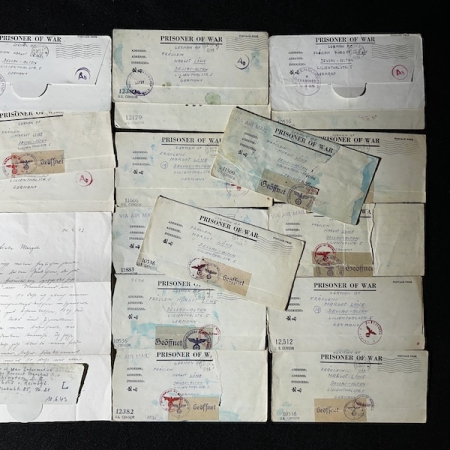
Original German DAK Officer Oberleutnant Egbert von Reinöhl – Flakabteilung 85 – German High Command Censor Rare Lot
An interesting lot of POW Mail from Oblt Egbert von Reinöhl. He was captured in North Africa in mid 1943, and was moved to various camps in the USA. His letters are all highly censored by the German High Command, every envelope was opened first by US Censor and then in Germany. Including a water ink test to look for invisible ink. All letters are nicely detailed, this would make a great research project.
-

Original Wartime Book Nazi Propaganda – Hitler Baut Grossdeutschland – Zeitgeschichte Verlag – Berlin 1938 – Images from Heinrich Hoffmann (Sold)
An interesting booklet, glorifying Hitlers rise and fuelling a myth of success to the German people. This is sold for historical purposes only and according to our Terms and Conditions.
-

Post War Signed Luftwaffe Ace Horst Petzschler – Air Ace – F190 JG 52
Great history on this website of Horst: German, FW-190 Ace, Horst Petzschler
-
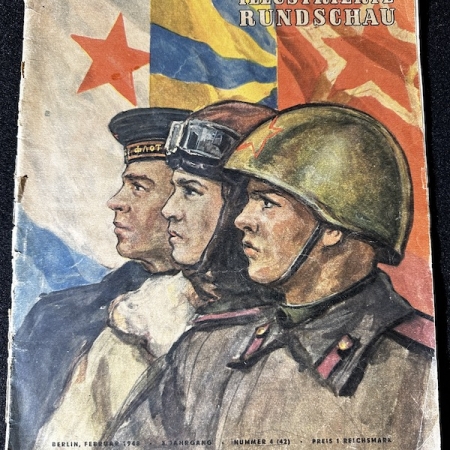
Soviet Occupation Army of Berlin Feb 1948 – Illustrierte Rundschau – Interesting Content Rare Magazine – Rare
Original Magazine Illustrierte Rundschau Feb 1948
-
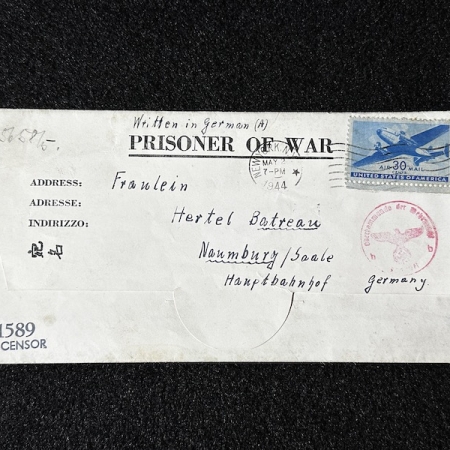
WWII German Army POW – Communist Willy Seigmeyer – Censored Political Prisoner in 999 Penal – Captured in Afrika Korps sent to USA – Colorado Springs Camp Carson – Rare
An incredible set of Feldpost here to the “Communist Willy Siegmeyer” Sent from Soldat Willy Seigmeyer Schutzen-Regiment 962 – Penal unit destroyed in Tunis with the German Africa Corps Regiment 962 and 961 were formed at the end of 1942 in Belgium as Disciplinary 999 Brigade and were based in the Antwerp Region. A so called “Bewahrungseinheit” or “Strafbattalion” were German soldiers who had done some kind of failure ( Theft’s, almost Deserter’s, or so called “Cowards in the front of the Enemy”, and so on. Being in this unit was the only chance of Rehabilitation, it’s debated as to whether this unit was a penal unit, dispite this assumption the ordinary ranks were not permitted to wear the National Eagle, collar patches or cockade on their uniforms, nor were they allowed to wear the traditional army belt with the National Eagle displayed on them. In March 1943 the unit had reached up to Division size and became 999 Division, at the same time 961 and 962 rifle Regiments ( MOT ) were sent to North Afrika and were redesignated as the 999th Leichte Afrika Division. Actual units in N.Afrika were. Willy Siegmeyer is mentioned here: Naumburger in opposition and resistance against National Socialism “Geboren am 25. März 1911, Kellner, Schreberstraße 15, 9 Monate 1933/1934 inhaftiert, 1942 Strafbataillon 999, verstorben am 21. November 1977.” “Born on March 25, 1911, Kellner, Schreberstrasse 15, imprisoned for 9 months in 1933/1934, 1942 Penal Battalion 999, died on November 21, 1977.” https://www.naumburg-geschichte.de/geschichte/uebersichtwiderstand.htm ( Collected before – Collection of Walter Grunert, Naumburg ) The grouping consists of: Letter sent from 48398 E – Schutzen-Regiment 962 – 25.2.1943 – Sent from Africa to Hertel from Soldat W. Seigmeyer POW Letter Sent – 2nd of May 1944 -7.PM New York City, USA – US Airmail Stamp – to Hertel Batreau – Censored By US Censor 11589 – Arrived in Germany – Censored by German High Command – Inside – Water/Ink Censor – Sent from POW Camp Carson USA. Collectors Remarks – Short synopsis in German language – Post from the communist Willy Siegmeyer, after years in prison he was sent to the Front with Penal Unit 999. In Africa, he made it to US lines as a POW. Letter from his time as a POW on 2nd of May 1944. More on Camp Carson Fort Carson was established in 1942 as Camp Carson in the months after the US entry into World War II. It was named after a frontiersman, trapper, Indian fighter, and general, “Kit” Carson. During WWII, Fort Carson was a training center for about 125 units, most famously the 10th Mountain Division. Carson also trained all sorts of other personnel, including cooks, nurses, tank battalions, and Greek infantry and Italian ordnance units. Fort Carson, just south of Colorado Springs, made an ideal location for training mountain units for deployment to the European Alps or other mountainous areas. The demands of such terrain required Fort Carson to maintain the last mule trains in the US Army. From Fort opening to 1956, mule teams packed gear for Army mountain units; the senior mule, Hambone, served as mount for First Sergeants for thirteen years, survived until 1971, and was buried with full military honors. On the first day of 1943, Camp Carson opened a POW camp for about 9,000 German, Italian prisoners. The POWs worked to relieve a manpower shortage in Colorado, farming and canning and generally providing labor, for a low but real wage. Camp Carson became a fort in 1954, expanded its base land considerably in the 1950s and 1960s, and became home to armor units; today Fort Carson is home to the 10th Special Forces Group, 4th Infantry Division, and a large and varied collection of other and tenant units. https://www.fortcarsonhousing.com/history Final Comments: There are not many stories like this and makes for a prime research project first source material.
-

Cold War Begin – 1948 Berlin Airlift – Operation Vittles Movie – NBC / ABC Reporter Nancy Craig – Berlin Interview with Berliner Dr Rainer Hildebrandt – Check Point Charlie Museum Founder – Bad Treatment East Germany 1949 – Woman of Tomorrow – Coast to Coast Radio Show – Radio Geneve – US Airforce – Tempelhof Berlin 1948 – Rare
Really interesting lot here, Nancy Craig was a reporter for NBC, it seemed she interviewed Dr R. Hildebrandt Rainer Hildebrandt, son of the art historian Hans Hildebrandt and the painter Lily Hildebrandt, studied physics in Berlin, later philosophy and sociology at the Faculty of Foreign Studies, and earned his doctorate under Franz Rupp on a topic in psychology.[1] At his university, a lively circle of resistant lecturers and students gathered from 1939/40 on. Among them were Harro Schulze-Boysen and Horst Heilmann as well as the professor Albrecht Haushofer and the student Rainer Hildebrandt. He had contact with the wider circle of the July 20, 1944, conspirators and was a member of the Haushofer circle: “A long look goes out to the companions. I lost my best friends, Albrecht Haushofer and Horst Heilmann, in the Nazi Reich and was myself imprisoned for 17 months. I learned to fight against injustice.” Hildebrandt was imprisoned for “Wehrkraftzersetzung” and connections to resistance groups. After the beginning of the Cold War, Hildebrandt, together with the writer Günther Birkenfeld, the then chairman of the Junge Union Ernst Benda and the then FDP city councilor Herbert Geisler, founded the anti-communist Kampfgruppe gegen Unmenschlichkeit (KgU), which was financed by secret services, as a licensee of the Allied Command. At the beginning, this Kampfgruppe was headed by Rainer Hildebrandt, whose main goal was initially to set up a tracing service to track down the many arrested and disappeared or abducted and missing and deceased persons in the Soviet occupation zone. Other files existed in parallel, such as one of denunciators who had imprisoned fellow citizens or those that provided information on the political, economic and military situation. According to his own account, there were three kidnapping attempts against Hildebrandt, including by the GDR State Security. According to Hildebrandt’s recollections, the first kidnapping attempt failed on July 24, 1949. After his retirement from the KgU, Hildebrandt devoted most of his time to public relations work and then to the Arbeitsgemeinschaft 13. August, which was founded shortly after the construction of the Berlin Wall. Until the end, Hildebrandt directed the Checkpoint Charlie Museum. On October 1, 1992, Hildebrandt was awarded the Order of Merit of the State of Berlin, and in 1994 Roman Herzog awarded him the Federal Cross of Merit I Class. In 1995 Hildebrandt married Alexandra Hildebrandt. On January 9, 2004, Rainer Hildebrandt died at the age of 89. In 2004, the International Human Rights Award Dr.-Rainer-Hildebrandt-Medaille was established. It is awarded annually since 2005 to individuals who have campaigned for human rights in a non-violent manner. The jury includes Henry Kissinger, Avi Primor, Joachim Gauck, Hans-Dietrich Genscher, and Sergei Khrushchev. https://en.wikipedia.org/wiki/Rainer_Hildebrandt Here is the Op Vittles information and video clip. https://www.c-span.org/video/?464908-1/operation-vittles
